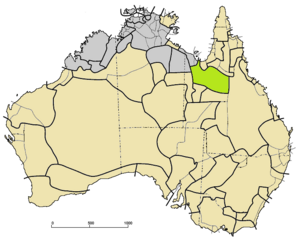Mayabic languages facts for kids
Quick facts for kids Mayabic |
|
|---|---|
| Mayi | |
| Geographic distribution: |
Queensland |
| Linguistic classification: | Pama–Nyungan
|
| Subdivisions: |
—
|
 Mayabic languages (green) among other Pama–Nyungan (tan)
|
|
The Mayabic (say: May-a-bik) languages, also known as Mayi (say: May-ee), are a small group of Australian Aboriginal languages that are now extinct. This means no one speaks them anymore. These languages were once spoken by Aboriginal people in the region of Queensland, Australia.
Long ago, these languages were thought to be part of a larger group called Paman. However, experts now believe they form their own special branch within the even bigger Pama–Nyungan language family. This family includes many Aboriginal languages across Australia.
What Are the Mayabic Languages?
The Mayabic language family includes several distinct languages. Each of these was once spoken by different Aboriginal communities.
The main languages in this family are:
- Mayi-Kutuna
- Mayi-Kulan (which included dialects like Mayi-Thakurti and Mayi-Yapi)
- Ngawun (which included a dialect called Wunumara)
Experts sometimes disagree on whether some of these were separate languages or just different ways of speaking the same language. For example, some thought Wunumara was a dialect of Ngawun or Mayi-Kulan. However, other experts list all six names above as completely separate languages.
Why Are These Languages Important?
Even though the Mayabic languages are no longer spoken, they are very important. They help us understand the rich history and culture of the Aboriginal people of Queensland. Studying these languages can teach us about how people lived, thought, and interacted with their environment.
Linguists (people who study languages) work to record and understand these extinct languages. They use old notes, recordings, and writings to learn as much as possible. This helps preserve the knowledge and heritage of the Aboriginal communities for future generations.
See also
 In Spanish: Lenguas mayábicas para niños
In Spanish: Lenguas mayábicas para niños

